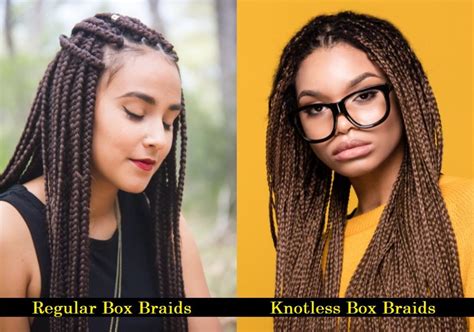Introduction
The world of protective hairstyles is vast and ever-evolving, with two timeless favorites standing tall: knotless braids and box braids. Both techniques create stunning, versatile looks, but which one is right for you? In this comprehensive guide, we delve into the intricate details of each method, comparing their advantages, disadvantages, and unique styles to help you make an informed choice.

Knotless Braids: The Gentle Giant
Knotless braids, also known as invisible braids, have taken the hair care industry by storm with their seamless blend and gentle touch on your scalp. As the name suggests, knotless braids are crafted without the use of knots at the root, creating a more natural-looking and less bulky style.
Advantages:
-
Natural Look: Knotless braids seamlessly integrate with your natural hair, giving the illusion of thicker, fuller hair. They are a perfect choice for those who want a protective style that looks effortlessly chic.
-
Scalp Comfort: The lack of knots at the root eliminates tension and tugging on the scalp, making knotless braids a comfortable option for all-day wear.
-
Protective: Knotless braids effectively protect your natural hair from breakage, tangles, and environmental damage.
Disadvantages:
-
Time-Consuming: Knotless braids require more time and patience to install than box braids due to their intricate knotless technique.
-
Durability: Knotless braids may not last as long as box braids due to the lack of knots at the root.
Box Braids: The Timeless Tradition
Box braids, a staple in African hair culture, have graced the heads of countless women for centuries. Their sharp angles and intricate patterns exude confidence and versatility.
Advantages:
-
Durability: Box braids are renowned for their longevity, lasting up to several weeks or even months with proper care.
-
Versatile: Box braids offer endless styling possibilities, from intricate updos to sleek ponytails, making them a perfect choice for those who love to experiment with their look.
-
Protective: Box braids provide excellent protection for natural hair, shielding it from damage and promoting growth.
Disadvantages:
-
Scalp Tension: The tension created by the knots at the root can cause discomfort for some individuals.
-
Bulkiness: Box braids can be quite bulky, especially when installed with thicker extensions.
Which Style is Right for You?
The choice between knotless and box braids ultimately depends on your individual preferences and hair type. Consider the following factors:
-
Scalp Sensitivity: If you have a sensitive scalp, knotless braids may be a more comfortable option.
-
Hair Length and Thickness: Knotless braids can be created with shorter hair lengths and finer hair textures, while box braids are suitable for longer hair and can accommodate thicker extensions.
-
Style Preference: If you prefer a natural-looking style, knotless braids are a great choice. For sharp angles and bold patterns, box braids are the way to go.
Step-by-Step Braiding Guide
Knotless Braids
Materials:
- Hair extensions (optional)
- Rat tail comb
- Edge control (optional)
- Hair clips
- Scissors
Steps:
- Divide your hair into small sections.
- Create a small knot at the root of each section.
- Feed the hair extension into the knot and begin braiding.
- Continue braiding until you reach the desired length.
- Seal the ends of the braids with hot water or a hair sealant.
Box Braids
Materials:
- Hair extensions
- Rat tail comb
- Crochet hook
- Edge control (optional)
- Hair clips
- Scissors
Steps:
- Divide your hair into small square sections.
- Create a three-strand braid at the root of each section.
- Insert the hair extension into the braid and continue braiding.
- Use a crochet hook to tighten the braids.
- Dip the ends of the braids in hot water or use a hair sealant.
Care and Maintenance
Both knotless and box braids require proper care to maintain their beauty and longevity.
-
Washing: Wash your braids regularly using a sulfate-free shampoo and conditioner. Avoid using hot water, as it can dry out the hair and cause frizz.
-
Detangling: Gently detangle your braids using a wide-toothed comb or a detangling brush. Avoid brushing too vigorously, as it can cause breakage.
-
Moisturizing: Keep your braids hydrated by applying a lightweight oil or leave-in conditioner. Focus on the scalp and the ends of the braids to prevent dryness.
-
Protection: Wear a satin scarf or bonnet to protect your braids from friction and tangles while you sleep.
Frequently Asked Questions
-
Which style lasts longer, knotless or box braids?
– Box braids typically last longer than knotless braids due to the knots at the root. -
Are knotless braids better for your hair?
– Yes, knotless braids are generally considered gentler on the scalp and hair than box braids. -
Can you dye knotless or box braids?
– Yes, you can dye both knotless and box braids. However, it’s important to use a dye specifically designed for synthetic hair. -
How often should I take down my braids?
– It’s recommended to take down your braids every 6-8 weeks to prevent hair damage and scalp irritation. -
Can I use my own hair for knotless or box braids?
– Yes, you can use your own hair for both knotless and box braids. However, it’s important to note that the braids will not be as durable as when using extensions. -
How can I prevent hair loss from braids?
– Make sure your braids are installed properly and not too tight. Wash your braids regularly and avoid using harsh products. Protect your braids from friction and tangles while you sleep.
Conclusion
Whether you choose knotless or box braids, you’re in for a stunning and versatile protective style. By understanding the unique features, advantages, and disadvantages of each method, you can make an informed decision that matches your personal style and hair needs. With proper care and maintenance, your braids will thrive, keeping your hair healthy and your look fabulous.
